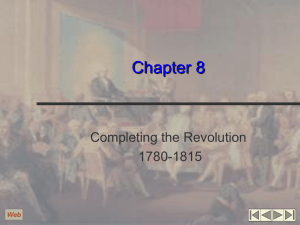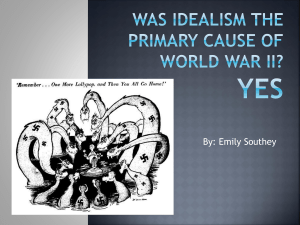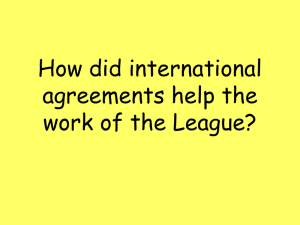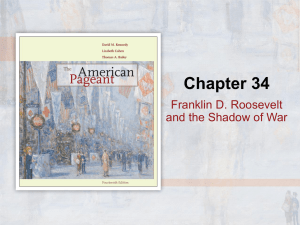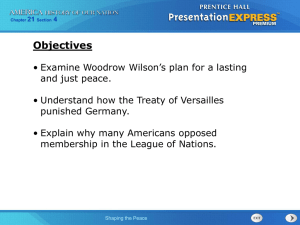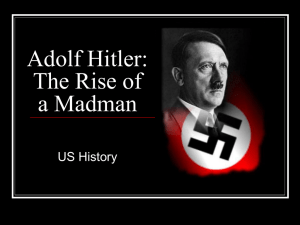GCSE History Revision: Paper 1
advertisement
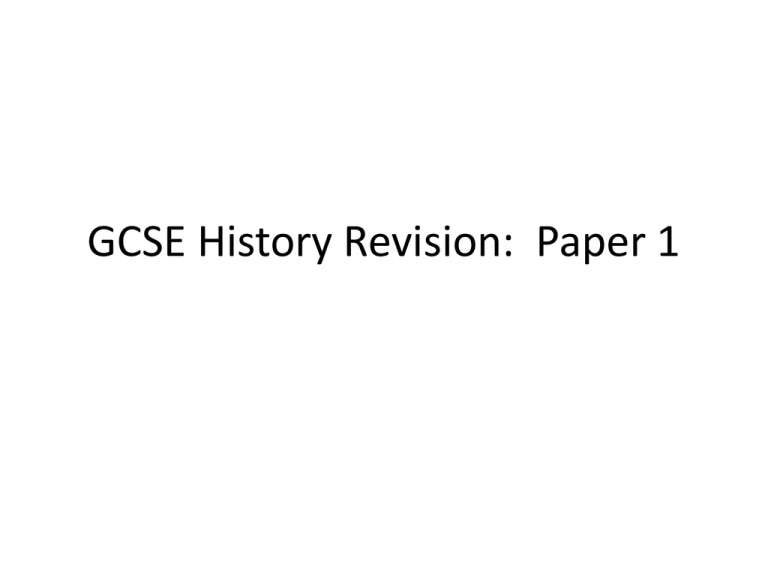
GCSE History Revision: Paper 1 Outline of the Day 9.30-45am Paper 1 Content Overview 9.45-10.45am Hitler’s Foreign Policy and the Causes of the Second World War 10.45-11.00am BREAK 11.00-12.00 Causes of the FWW 12.00-1.00pm LUNCH 1.00-2.00pm Treaty of Versailles and League of Nations 2.00-2.15pm BREAK 2.15-3.15pm Exam Technique Paper 1: Structure and Content 1hr 45mins The 1st 3 topics…answer ALL 3! 35mins per section = 1.5mins/mark 4marks = 6mins 6marks= 9mins 10marks = 15mins This gives 5mins to read and plan!!! Topics you MUST answer Paper 1: Topic 1 Paper 1: Origins of the First World War Key Question: Why were Development of the Triple Alliance, Entente Cordiale and Anglo-Russian there two armed camps in Agreement: Britain’s emergence from splendid isolation Europe in 1914? Kaiser Wilhelm II’s aims in foreign policy; Weltpolitik; a “place in the sun”; attitudes towards Great Britain; development of the Navy The Moroccan Crises of 1905 and 1911 and their effects on the alliances The Bosnian Crisis 1908-09 and its effects on the alliances The arms race – military and naval: why did countries increase the size of their armies? The Anglo-German Naval Race Key Question: Why did Aims of the Austria-Hungary and Serbia in the Balkans: the role of the Black war break out in 1914? Hand The assassination at Sarajevo: Gavrilo Princip; the response of AustriaHungary; the ultimatum and Serbia’s response The events leading to war; the role of the alliances in 1914 The Schlieffen Plan and its effects on the outbreak of war; its part in bringing about Great Britain’s declaration of war on Germany Responsibility for the outbreak of war and the escalation of the conflict MAIN causes of the FWW M Militarism A Alliances I Imperialism N Nationalism What were the MAIN causes? • M - militarism (increasing the size of your army or navy) • A – alliances (countries promising to help each other) • I – imperialism (powerful countries wanting to increase their power by taking other countries) • N – nationalism (being prepared to fight THINK for ones country) Can you think of any examples of how the main European countries tried to increase their power? Alliances Triple Alliance 1. 2. 3. Triple Entente 1. 2. 3. DEFENSIVE ALLIANCES What is this image linked to? Sage and Scribe SCRIBE NAME: SCRIBE NAME: Who was King of Germany in 1900? When was the Triple Alliance signed? Which countries made up the Triple Alliance? What does “splendid isolationism mean”? What two things happened that made Britain When was the Entente Cordiale signed? think about ending it’s policy of “splendid isolationism”? Which countries signed the Entente Cordiale? What does Entente Cordiale mean? What was the German foreign policy called? (In German or English) When was the Triple Entente signed? The Kaiser states he supports an independent Morocco Kaiser was humiliated Germany was given two marshy strips of land in the French Congo A-H supported Moroccan independence France was given overall control of Morocco but not allowed any military presence Germany sent the gun boat the Panther to protect German interests Brought Europe close to war Britain signed a secret naval agreement with France to protect the north coast Germany was annoyed and humiliated Germany was annoyed and humiliated Germany wanted to expand it’s empire as part of WELTPOLITIK Rebellion in Fez Kaiser visits Tangier A conference was held at Algeciras, Spain Britain believed Wilhelm was trying to set up a naval base Italy opposed Germany – this weakened the TA The Kaiser was testing the strength of the Entente Cordiale Britain and Russia supported France Britain mobilised France felt more it’s navy in Gibraltar confident of Britain’s support Kaiser visits Tangier France was given overall control of Morocco but not allowed any military presence Morocco The Kaiser states he supports an independent Morocco Britain and Russia supported France Britain believed Wilhelm was trying to set up a naval base Germany wanted to expand it’s empire as part of WELTPOLITIK Britain signed a secret naval agreement with France to protect the north coast The Kaiser was testing the strength of the Entente Cordiale A conference was held at Algeciras, Spain Kaiser was humiliated Rebellion in Fez Germany was given two marshy strips of land in the French Congo A-H supported Moroccan independence Italy opposed Germany – this weakened the TA Germany sent the gun boat the Panther to protect German interests France felt more confident of Britain’s support Brought Europe close to war Britain mobilised it’s navy in Gibraltar Germany was annoyed and humiliated Where is this? ANNEXED = a country is taken and made part of another empire Austrian leader Franz Josef taking BosniaHerzegovina from the Turkish Sultan Bosnia, 1909-09 Bosnian Crisis, 1908-09 • • • • • • • • • • Ottoman Empire (Turkish Empire) was breaking up Serbia wanted to unite all SLAVS – Yugoslavia Russia and Serbia = allies Russia called for an international conference to discuss Bosnia A-H refused to attend Germany supported A-H because of their support during Morocco Russia had to back down as it was not ready to fight Germany Serbia wanted revenge against A-H Russia was humiliated and now unlikely to back down A-H had the support of Germany – even if it meant war this was important in 1914 • Russia became closer to Br and Fr Arms Race and the First World War: Increase in Spending D e fe n c e S p e n d in g , 1 8 7 0 -1 9 1 4 400 350 300 250 200 150 100 50 £m 1870 1880 1890 1900 1910 1914 94 130 154 268 289 398 There was a four-fold increase in defence spending of the great powers, 1870-1914. Arms Race and the First World War: This British postcard interprets Kaiser Wilhelm’s statement about wanting ‘a place in the sun’ – it shows him making everybody in the world bow down to him. IMPERIALISM led to an arms race … in 1900, Kaiser Wilhelm said that GERMANY wanted ‘a place in the sun’ – i.e., that Germany wanted an empire as big as Britain’s. This TERRIFIED the British. Arms Race and the First World War: Attitude towards war But note that militarism is also a government's attitude of mind, seeing war as a valid means of foreign policy. (GERMANY was especially militaristic.) Arms Race and the First World War: As well as their STANDING ARMIES, the nations introduced CONSCRIPTION, so they also had large numbers of trained RESERVES. All the nations except Britain had HUGE armies. Arms Race and the First World War: Navies If GERMANY was to have an empire, it needed a navy, so in 1900 Admiral Tirpitz introduced the German Navy Law, which announced a huge programme of building warships. Arms Race and the First World War: Navies Both BRITAIN and GERMANY started building Dreadnoughts – the most advanced class of warship in the world. The Dreadnought essentially reduced everybody else’s number of warships to zero. B u ild in g D re a d n o u g h ts , 1 9 0 6 -1 9 1 4 8 6 4 2 0 1906 1907 1908 1909 1910 1911 1912 1913 1914 G erm any 0 0 4 3 1 3 2 3 1 G reat B ritain 1 3 2 2 3 5 3 7 3 Anglo-German Naval Race – Who is the winner? Arms Race and the First World War: T o ta l D re a d n o u g h ts 30 25 20 15 10 5 0 1906 1907 1908 1909 1910 1911 1912 1913 1914 G erm any 0 0 4 7 8 11 13 16 17 B ritain 1 4 6 8 11 16 19 26 29 In the end, Britain’s built many more Dreadnoughts than Germany. Naval Race Arms Race and the First World War: Effects The arms race was tied in to both NATIONALISM and IMPERIALISM. It increased SUSPICION and HATRED of other nations - and it gave the nations the WHEREWITHAL to wage war. What event is this? Assassination • • • • • • • • • Where is Sarajevo? Who was visiting Sarajevo in June 1914? Why was he visiting Sarajevo? What was the name of the terrorist group planning to assassinate him? When was this group formed? How many members did this group have by 1914? What were the aims of this group? Which country was the group connected to? What was the name of the assassin? Assassination • Where is Sarajevo?Bosnia • Who was visiting Sarajevo in June 1914?Archduke Franz Ferdinand • Why was he visiting Sarajevo?To encourage positive relations between A-H and the local people • What was the name of the terrorist group planning to assassinate him? Black Hand Gang • When was this group formed?1911 • How many members did this group have by 1914?2,500 • What were the aims of this group? unite all Serbs in to a greater Serbia • Which country was the group connected to?Serbia • What was the name of the assassin? Gavrillo Princip Steps to War 28th June Russia offers support to Serbia 6th July Germany declares war on France; German troops enter Belgium 23rd July A-H sends ultimatum to Serbia 24th July France declares war on Germany 28th July A-H declares war on Serbia 30th July Germany promises to support A-H= “blank cheque” 1st August A-H declares war on Russia 3rd August Russia mobilises it’s armed forces 4th August Assassination of Archduke Franz Ferdinand 5th August Germany declares war on Belgium; Britain declares war on Germany 6th August Germany declares war on Russia Details… • Name the Count who wanted to go to war with Serbia • How many points did A-H send Serbia in their ultimatum? • Which point did Serbia not agree too? • Why? • What was the German plan of attack called? • What was it designed to avoid? • What was the treaty with Belgium called? • When was it signed? Details… • Name the Count who wanted to go to war with Serbia. Count Hotzendorf • How many points did A-H send Serbia in their ultimatum? 10points • Which point did Serbia not agree too?point 6 • Why? Gave A-H control of Serbia’s court system • What was the German plan of attack called?Schlieffen Plan • What was it designed to avoid?A war on two fronts (sides) • What was the treaty with Belgium called?Treaty of London • When was it signed? 1839 Schlieffen Plan Effect of the SP • Britain had no intention of supporting Russia • Would have been difficult for Britain to convince the people to go to war over France • BELGIUM = opportunity • 1839 – Treaty of London = “scrap of paper” by the Kaiser • British people shocked by German aggression towards a small country like Belgium! Which country was responsible for war? Country Responsibility France The French were determined to get revenge on Germany for defeat in 1871 and their attempts to expand in to Morocco. Britain The British took part in the naval race and supported France during the Moroccan Crises; it also declared war on Germany in August 1914 Russia Tsar (King of Russia) fully supported Serbia Germany Weltpolitik threatened Britain and France A-H A-H was determined to crush Serbia Serbia Serbia was determined to create a Greater Serbia and the BHG assassinated Franz Ferdinand Paper 1: Topic 2 Paper 1: Peacemaking 1918-19 and the League of Nations Key Question: How did the The Paris Peace Conference; the aims of Clemenceau, Lloyd George and Treaty of Versailles establish Woodrow Wilson: the Fourteen Points peace? The main terms of the Treaty of Versailles; Diktat; territorial changes; military restrictions, war guilt and reparations The strengths and weaknesses of the Treaty of Versailles: Why Germany objected to it Key Question: Why did the Membership 1919-39: why and how it changed; implications for the League of Nations fail in its League of Nations aims to keep peace? Organisation, powers and peace keeping role: the Assembly; the Council; the Permanent Court of Justice; military and economic sanctions The Manchurian Crisis 1931-33: events; actions taken by the League; effect on the League as a peacekeeping force The Abyssinian Crisis 1935-36: events; action taken by the League; effect on the League as a peacekeeping force The reasons for the collapse of the League Who’s Who? Who’s Who? What did they want? ______________________ _____________________ ______________________ Characters Personal Aims Georges Clemenceau David Lloyd George Woodrow Wilson Aims of the Nation the Represent Cripple Germany’s economy Prevent future threats from Germany Germany should be punished but not too harshly A harsh treaty might lead to another war Make Germany suffer Self-determination International cooperation – League of Nations Britain and Germany to trade in the future Cripple Germany’s economy Prevent future threats from Germany International cooperation – League of Nations Germany should be punished but not too harshly Self-determination Britain and Germany to trade in the future A harsh treaty might lead to another war Treaty of Versailles Maths Challenge Question 1 A. How many soldiers were the German army allowed under the Terms of the Treaty of Versailles? Write the answer down. B. Clemenceau, Wilson and Lloyd George made up the Big Who? Write the answer down. • Multiple these two answers. Now write the answer to question 1 down. Question 2 A. How many battleships was Germany allowed under the terms of the Treaty of Versailles? Write the answer down. B. How many points did Wilson have? Write the answer down. C. What number was the War Guilt Clause? Write the answer down. • Multiple these three answers. Write the answer for question 2 down. Question 3 A. Subtract the question 2 answer from your question 1 answer. • Now write the answer to question 3 down. Question 4 A. How many years were there between the Treaty of Versailles being signed and the time the reparations figure was set? Write the answer down. B. How many years was the Saar region to be given to France? Write the answer down. • Multiple these two answers. Now write the answer to question 4 down. Question 5 A. Add the answer from question 3 with the answer to question 4. • Now write the answer to question 5 down. Question 6 A. To the nearest year – how many years did the First World War last? Write the answer down. • Write the answer to question 6 down. Question 7 A. Add the answer from question 5 with the answer to question 6. • Now write the answer to question 7 down. Question 8 A. What time did the Armistice ceasefire begin on 11th November 1918? Write the answer down. B. Write the answer to question 8 down. Question 9 A. Subtract the question 8 answer from your question 7 answer. • Your solution is: Solution 280619 Treaty of Versailles was signed on 28th June 1919 – 28/06/19 Treaty of Versailles_______ Land TofV Military Guilt and Compensation Treaty of Versailles 28th June 1919 Danzig=Free City Alsace-Lorraine=France North Schleswig=Denmark Land Colonies = mandates West Prussia and Posen = Poland Anschluss forbidden Rhineland demilitarised TofV Saarland = LoN for 15 years Article 231=War guilt clause No conscription Military Army limited to 100,000 No subs or aircraft 6 battleships Guilt and Compensation Young Plan 1929 £6.6billion set in 1921 Pay until 1984! Was it fair? Yes it was fair… No it was not fair… • • • • • • • • • • • British and French casualties=9million 750,000 homes destroyed Britain=£1billion in debt to USA Food shortages Devastation in Belgium and France Treaty of Brest-Litovsk: 34%pop; 54% industry; 89% coalmines Treaties – St Germain (Austris)=lost Bosnia, Herzegovinian and Croatia; restiricted army to 30,000. Neuilly(Bulgaria)=Lost land to Greece and Yugoslavia; Armed forced limited to 20,000; £100million in reparations. Trianon (Hungary) = Lost land to Romania, Czechoslovakia and Yugoslavia; lost 3 million people to other states; due to pay reparations. Sevres (Turkey) = Lost land to Greece other land became a LofN mandates; Palestine. • • • • • 10% of land All colonies 12.5% population 50% of iron and steel industries War guilt clause No German representative Economy in ruins Army restrictions too small German people split up Strengths and Weaknesses of the TofV Strengths Weaknesses Brought peace to Europe Germany was left very unhappy Fairer that other treaties – A-H was divided Germany could not afford to make reparation payments Germany had imposed a much harsher treaty on Russia (Treaty of Brest-Litovsk in 1918) The treaty did not punish Germany enough to stop her seeking revenge Wilson put too much faith in the loN TASK: For each of the terms of the Treaty of Versailles, say whether you think its main aim was: Do you think this term was fair/unfair/unsure? Explain your answer. Germany had to pay £6,600 million, called reparations, for the damage done during the war. Germany forbidden to have submarines or an air force. She could have a navy of only 6 battleships. Germany lost land in Europe Germany could only have an army of 100,000 men. Germany’s colonies were given to Britain and France. Germany was split in two so that the newly created Poland could have access to the sea. Alsace-Lorraine given back to France. Germany could never unite with Austria Demilitarised the Rhineland - Germany was not allowed to place any troops in the Rhineland, the strip of land, 50 miles wide, next to France. War Guilt: Germany had to accept the blame for starting the war. Germany could not join the League of Nations. The League of Nations Membership of the League Britain Italy 1933 Germany 1933 USSR 1934 USA 1919 1929 1939 Membership of the League France Britain Italy 1937 Japan 1933 Germany 1933 1926 USSR USA 1934 NEVER JOINED 1919 1929 1939 Covenant • 26 rules (articles) • Registration of all treaties to avoid secret alliances • Reduction of arms so no future arms race • Collective security to solve problems The League of Nations Encourage co-operation Stop aggression AIMS Disarmament Improve social conditions Structure The Assembly Each country one vote Permanent court of International Justice Based at The Hague Settle disputes peacefully No power of enforcement The Council Met several times a year and in emergencies 5 permanent members Each had right to veto any idea The Secretariat Kept records - civil service What event is this source commenting on? What is the message of this cartoon? List the key events of the Manchurian crisis and explain how they show the failure of the League. List the key events of the Manchurian crisis and explain how they show the failure of the League. September 1931 - Railway attacked in Japanese controlled Manchuria Italy was putting it’s own interests first. Invading Manchuria in order to tackle problems brought on by the Depression of the 1930s. February 1932 – Manchukuo China appealed to the LofN. Japan said it was solving a local – Japan set up a puppet problem and acted in this way as a form of self-defence. government in Manchuria September 1932 – Lytton Report states that Japan acted unlawfully The LofN sent an official to investigate Japan’s claims of selfdefence. The Report took 12mths to compile. The report was approved 42 votes to 1…Japan being the one! February 1933 – Japan invades the rest of Manchuria Despite the LofN stating that Japan had done wrong nothing was done! Japan continued to expand on the same principle of self-defence. Economic sanctions were not an option as the USA was it’s main trading partner. Also Britain did not want to risk it’s colonies in SE Asia by upsetting Japan. It was too far away to start a war over. March 1933 – Japan withdrew from the League and invades Jehol province The League was powerless. The League did not have the resources to remove Japan by force. Aggressive behaviour wins! Abyssinia - Timeline December 1934 October 1935 December 1935 May 1936 1937 Abyssinia - Timeline December 1934 Italian troops provoke a clash at Wal Wal October 1935 Italian invasion begins December 1935 Britain and France produce Hoare-Laval Plan. Large parts of Abyssinia to be given to Italy in return for Italian withdrawal. Public outcry- plan abandoned May 1936 Haile Selassie was forced in to exile and the Italian conquest complete November 1936 Rome-Berlin Axis signed 1937 Italy withdraws from the League Manchurian and Abyssinian Crises CAUSES Manchurian Crisis Abyssinian Crisis EVENTS EFFECTS ON THE LEAGUE Abyssinia was the only independent Africa country in that area Wall Street Crash in 1929 meant that Japan lost trade with the USA. Japan invaded the next province Jehol Manchuria was rich in natural resources China appealed to the League for help. Lytton Commission was set up to investigate Chinese soldiers were accused of blowing up part of the Japanese railway The League condemned the actions of Japan and told Japan to leave the area. The League encouraged aggressive actions from Germany and Italy Well at WalWal were attacked. Italy invaded. Mussolini wanted to increase Italy’s power Haile Selassie appealed to the League for help Italy wanted revenge for defeat in 1896 The League had failed to deal effectively with Japan The League imposed sanctions on glass, rubber and weapons Britain and France were not willing to support the League by providing an army Britain and France tried to get Italy to agree to the Hoare-Laval Pact – this would give Italy 2/3 of Abyssinia League members were not willing to stop aggressive countries Britain and France were undermining the League The League was no longer taken seriously Manchurian Crisis CAUSES EVENTS EFFECTS ON THE LEAGUE Wall Street Crash in 1929 meant that Japan lost trade with the USA. China appealed to the League for help. Britain and France were not willing to support the League by providing an army Manchuria was rich in natural resources Lytton Commission was set up to investigate The League had failed to deal effectively with Japan Japan invaded the next province Jehol Chinese soldiers were accused of blowing up part of the Japanese railway Abyssinian Crisis Abyssinia was the only independent Africa country in that area Mussolini wanted to increase Italy’s power Italy wanted revenge for defeat in 1896 Well at WalWal were attacked. Italy invaded. The League condemned the actions of Japan and told Japan to leave the area. Haile Selassie appealed to the League for help Britain and France tried to get Italy to agree to the Hoare-Laval Pact – this would give Italy 2/3 of Abyssinia The League imposed sanctions on glass, rubber and weapons The League encouraged aggressive actions from Germany and Italy League members were not willing to stop aggressive countries Britain and France were undermining the League The League was no longer taken seriously Questions on the League Economic depression Abyssinia/Manchuria Germany/Italy/Japan Organisation Why did it fail? Britain/France Aims Powers USSR/USA The league of nations failed because it… The League did not have any real power. Apart from shame, Weak sanctions didn’t work and it did not have it’s own army. America The strongest nation after the First World War never joined. Structure The League’s organisation was disorganised so it took a long time to do anything. Members couldn’t agree but decisions had to be unanimous. Depression World-wide depression causes countries to look for more land and power. Countries were more worried about themselves and not world peace. Unsuccessful The more the League failed the more people mistrusted it. In the end countries just ignored it. Members Big bullies The League’s main members let it down. The League showed it could deal with smaller countries in the 1920s. However when powerful countries like Germany, Italy and Japan defied the League the League was too weak to stop them TASK: Find an example to support each of these reasons. Weak The League did not have any real power. Apart from shame, sanctions didn’t work and it did not have it’s own army. America The strongest nation after the First World War never joined. Structure The League’s organisation was disorganised so it took a long time to do anything. Members couldn’t agree but decisions had to be unanimous. Depression World-wide depression causes countries to look for more land and power. Countries were more worried about themselves and not world peace. Unsuccessful The more the League failed the more people mistrusted it. In the end countries just ignored it. Members The League’s main members let it down. Big bullies The League showed it could deal with smaller countries in the 1920s. However when powerful countries like Germany, Italy and Japan defied the League the League was too weak to stop them •Source B A cartoon in Punch, a British magazine, 28 July 1920. The rabbit is saying ‘I don’t have any weapons (I am practically defenceless) so I must defeat him with a powerful stare’. •Source B A cartoon in Punch, a British magazine, 28 July 1920. The rabbit is saying ‘I don’t have any weapons (I am practically defenceless) so I must defeat him with a powerful stare’. Study Source B. Source B explains one of the weaknesses of the League of Nations in 1920. Do you agree that the lack of an armed force was the main weakness of the League of Nations when it was set up in 1920? Explain your answer by referring to the purpose of the source, as well as using its content and your knowledge. (6 marks) Paper 1: Topic 3 Paper 1: Hitler’s Foreign Policy and the Origins of the Second World War Key Question: How did Hitler challenge and exploit the Treaty of Versailles 1933-March 1938? Hitler’s aims in foreign policy The return of the Saar, 1935 The beginning of rearmament in Germany; withdrawal from the Disarmament Conference 1933; non-aggression pact with Poland 1934; reintroduction of conscription from 1935; Anglo-German Naval Agreement 1935 The remilitarization of the Rhineland 1936 Anschluss with Austria 1938 Key Question: Why did Chamberlain's policy of appeasement fail to prevent the outbreak of war in 1939? Reasons for and against appeasement The Sudeten Crisis and Munich Agreement, 1938 The collapse of Czechoslovakia, March 1939 The role of the USSR 1938-39: the Nazi-Soviet Pact Poland and the outbreak of war Responsibility for the outbreak of war How did Hitler challenge and exploit the Treaty of Versailles 1933-March 1938? • Hitler’s aims in foreign policy • The return of the Saar, 1935 • The beginning of rearmament in Germany; withdrawal from the Disarmament Conference 1933; non-aggression pact with Poland 1934; reintroduction of conscription from 1935; AngloGerman Naval Agreement 1935 • The remilitarization of the Rhineland 1936 • Anschluss with Austria 1938 Timeline 1933 Germany leaves the League of Nations Jan 1934 Hitler signs 10yr non-aggression pact with Poland July 1934 Mussolini prevents Anschluss with Austria Jan 1935 Saar returned to Germany April 1935 Stresa Front formed June 1935 Anglo-German Naval Agreement October 1935 Mussolini invades Abyssinia March 1936 Rhineland remilitarised October 1936 Rome-Berlin Axis 1936-39 Spanish Civil War May 1937 Chamberlain becomes Prime Minister – APPEASEMENT March 1938 Anschluss with Austria September 1938 Munich Conference March 1939 Collapse of Czechoslovakia August 1939 Nazi-Soviet Pact September 1939 Attack on Poland and the outbreak of WWII Timeline 1933 Jan 1934 Hitler signs 10yr non-aggression pact with Poland July 1934 Mussolini prevents Anschluss with Austria Saar returned to Germany April 1935 June 1935 Anglo-German Naval Agreement October 1935 Mussolini invades Abyssinia Rhineland remilitarised October 1936 Rome-Berlin Axis 1936-39 Spanish Civil War May 1937 Chamberlain becomes Prime Minister – APPEASEMENT March 1938 Munich Conference Collapse of Czechoslovakia August 1939 September 1939 Attack on Poland and the outbreak of WWII 1919, Treaty of Versailles = Germany “stabbed in the back” Hitler’s Aims This is what he SAID he wanted, now let’s see what he actually did. Unite all German speaking people in one single country. Hitler’s Aims Put right all the harm the Treaty Of Versailles has done to Germany and make Germany great again. Get lebensraum [living space] for all the Germany people. We need colonies and land to house our huge population. This is what he SAID he wanted, now let’s see what he actually did. Hitler’s Aims “It was necessary for us [the Nazi Party] to dig ourselves into the minds of the people as the enemies of the peace treaties so that the people give us their confidence.” MEIN KAMPF, 1923 This is what he SAID he wanted, now let’s see what he actually • What does this source mean? did. • Which parts of the treaty would he want to reverse to gain support? How did Hitler plan to achieve these aims? • Take back land lost • Bring the 7million German speakers in Austria and 4 million in Czechoslovakia and Poland in to his empire • Build up the armed forces to make Germany great again • Expand in the east and destroy Communism 10yr Non-Aggression Pact Rearmament German Foreign Policy 1933-35 Failed Anschluss Anglo-German Naval Agreement German Foreign Policy 1933-35 • • • • • • • 1932 – Disarmament Conference France= never disarm 1933 – Hitler withdrew from Conference 1935 –Gr introduced conscription 1935 – Br, Fr & It = Stresa Front against Germany TofV= unfair FR = not act alone • 1934 - Germany and Poland signed a 10yr non-aggression pact • Hitler promised not to take Polish corridor • Pleased Britain German Foreign Policy 1933-35 • 1934 – Austrian Nazi Party encouraged to rebel • Austrian Chancellor Dollfuss killed • Mussolini moved army to Austria to prevent Hitler from achieving Anschluss • Hitler not strong enough so backed down • 1935 – Britain pleased with Hitler • Germany navy limited to 35% of British navy • Britain agreed to German rearmament • Br acted without Fr or It • 1938 = 800,000 men; 47 u-boats; 2,000 aircraft Saar What were the terms of the TofV? • Under control of LofN for 15yrs • France allowed to taker coal during that time • 15 years a PLEBISCITE – LofN or Germany? Saar Plebiscite • 90% to reunite with Germany • LEGAL reversal of the TofV Rhineland Rhineland, March 1936 Describe • • • • Explain • • • • Assess • • • • 7th March 1936 Germany in to the Rhineland Broke the TofV and Locarno Pact League condemned the action German troops told to retreat if confronted Br & Fr more concerned with Mussolini and Abyssinia Fr = not prepared to act without Br Br = Hitler not doing anything wrong – “marching on to his own backyard” • No one wanted war • Br = TofV unfair Hitler = reversed TofV = confidence Hitler = more popular in Germany Rome-Berlin Axis (fascists working together) Failure of the LofN to keep peace ANSCHLUSS = UNION WITH AUSTRIA Unite all German speakers Rumours of Nazi plot to overthrow Austrian Gov Schuschni gg = appeal to Hitler for help SeyssInquart = Min of Interior = in charge of the police Riots by Austrian Nazis = not stopped by police Schuschnig g= PLEBISCITE to decide whether to join with Germany Hitler = troops to border, called for Schuschni gg to resign Br&Fr did nothing SeyssInquart = Chancellor Germans invited to restore order Austrian Plebiscite, April 1938 • 80,000 opponents arrested and put in concentration camps • April = plebiscite • 99.75% - YES vote for NAZIS RESULTS • • • • • • • • LofN = not consulted Br = TofV too harsh Br = feared communism more Austria = resources for Hitler to use TofV = reversal Hitler = more confident Germany = land on 3 sides of the Sudetenland Austrians welcomed Germany Why did Chamberlain's policy of appeasement fail to prevent the outbreak of war in 1939? FOR APPEASEMENT AGAINST APPEASEMENT Why did Chamberlain's policy of appeasement fail to prevent the outbreak of war in 1939? FOR APPEASEMENT AGAINST APPEASEMENT Avoid a war at all costs Hitler could not be trusted – broken promises since 1933 Depression Britain looked weak and encouraged Hitler League of Nations had failed Betrayed countries protected by the TofV Communism feared more than fascism Hitler increased strength and power Sudetenland, 1938 Why did Hitler want the Sudetenland? • Unite all German speaking people = 3million in the Sudetenland • Czech government accused of treating German speakers unfairly • Henlein = Czech Nazi campaigned for independence from Czech Munich Agreement Met at Bertesg aden, near Munich Hitler demands the Sudetenl and Areas with 50%+ German s to German y Czechs &Franc e agree Meeting at Godesber g Hitler makes new demands - land to Poland and Hungary Britain rejects demands – war preparatio ns begin Munich = Gr, Br, Fr, It Sudetenlan d to Hitler Importance of the Munich Agreement • • • • • • • Hitler = Sudetenland without fighting Czechoslovakia betrayed Peace preserved Czechoslovakia = vulnerable to invasion Germany = more resources Britain speeded up rearmament USSR felt left out and betrayed Czechoslovakia • Munich Agreement = break up of Czechoslovakia • October&November 1938 = Poland&Hungary gained land from Czechoslovakia • March 1939 = Slovaks press for independence too! • Hitler marches in to Czechoslovakia to restore order • Br&Fr protested but did not directly oppose! Result End of appeasement Hitler could not be trusted Memel (Lithuania) back to Germany Br&Fr signed an agreement to protect Poland Britain guaranteed the independence of Romania and Greece Hitler withdrew from the 10yr non-aggression pact with Poland and the Anglo-German Naval Agreement Rank What event? What event? Nazi-Soviet Pact When? Who? Nazi Soviet Pact What? Why? When? August, 1939 Why? Who? Ribbentrop = Germany & Molotov= Russia Nazi Soviet Pact Stalin prepare USSR for future attack Stalin unhappy with Br&Fr leaving him out of Munich Stalin= Br and Fr using Germany against USSR Hitler avoided a war on 2 fronts Br&Fr lost a possible ally What? Not to fight against each other in the event of war Secret agreement to divide Poland Invasion of Poland • April 1939 = Hitler demands Danzig • Believed Br and Fr wouldn’t go to war over Danzig • 3rd September 1939 = Br declared war on Germany 1st September 1939 Recap… Put the following events in chronological order Munich Agreement Anglo-German Naval Agreement The retaking of the Saar Czechoslovakia Invasion of Poland Nazi-Soviet Pact Rearmament Anschluss (2nd attempt) Rhineland Responsible for war…? EVENT Rearmament Anglo-German Naval Agreement The retaking of the Saar Rhineland Anschluss (2nd attempt) Munich Agreement Czechoslovakia Nazi-Soviet Pact Invasion of Poland SCORE International History, 1900-49 Test yourself 1. 2. 3. 4. 5. 6. Which British Prime Minister is most closely associated with appeasement? Name three countries that were appeased by Britain in the 1930s. In which year did Japan invade Manchuria? How large an army was Germany restricted to by the Treaty of Versailles? Which African state was invaded by Italy in 1935? Why did Britain try to turn a blind-eye to Mussolini's aggressive foreign policy in 1935? 7. In which war did both Germany and Italy support the fascist dictator General Franco? 8. Which clause of the Treaty of Versailles was broken by Germany in 1936? 9. Which country became part of Germany after the Anschluss of 1938? 10.What was the name of the largely German-speaking area of Czechoslovakia? 11.Who was the leader of the Sudeten Germans? 12.Essentially what was agreed to at the Munich Conference of 1938? 13.Which Polish port was claimed by Germany in 1939? 14.Which agreement between Germany and Russia prevented Russia from declaring war on Germany in 1939? 15.What is the German word for the eastward expansion of Germany's frontiers in the 1930s and 40s which aimed to provide new lands for the German people? 16.Why was Britain reluctant to formalise a defensive alliance with Russia in the 1930s? Know what each question is about 4 marks 6 marks 10 marks Exam Technique 4 mark questions • Based on simple knowledge • Need to be more than just bullet points • You need to describe (use knowledge to show) what is happening • E.g. • Think about what the league tried to do • Explain what they did So… • Firstly the League of Nations tried to P L2-2 solve the AbyssinianEvcrisis by... – This was where... Ex L2-3 – This would help solve the crisis because... P • Secondly the League tried to solve the Ev Abyssinian crisis by... Ex L3-4 – This was where... – This would help solve the crisis because... 6 mark questions • You Must use the source • You must use your knowledg e So… • Firstly I agree with the content of the L2-2 source as it shows ... P Ev Ex L3-4/5 – This tells me that... – (In addition this source was made by...which...) • HOWEVER, I also disagree P Ev with theEx source from my own knowledge... L4- 2 sides – I know that the League was also weak because... • In conclusion… L4-6 – Make a link, bring something new- develop your conclusion 10 mark questions • • • • • • • Dead easy to get good marks! Mini essay question It tells you what to talk about PEE to be used Argue one side Then the other Good conclusion to get top marks Use this grid to help you!!! Assess Explain Describe On the one hand On the other hand Assess Explain (Conclusion) Describe Use this grid to help you!!! On the one hand On the other hand Land that Germany lost • Danzig • Saar • Colonies Reparations enormous • 6.6 billion Why Germany hated this • 12.5% of pop • 10% of land • Industrial areas • Pride • strength Why Germany hated this • Economic collapse- WWI • War guilt unfair • Not agreed until 1921 • Punishing the wrong government Impact on the economy Harder to recover Can’t make reparations payments led to 1923 Ruhr and hyper inflation Humiliation- troops in Ruhr How do they link? Which is most important? Assess Explain (Conclusion) Describe Use this grid to help you!!! On the one hand On the other hand Land that Germany lost • Danzig L1-1 • Saar • Colonies Reparations enormous • 6.6 billion Why Germany hated this • 12.5% of pop L2-3/5 • 10% of land • Industrial areas • Pride • strength Why Germany hated this • Economic collapse- WWI • War guilt unfair • Not agreed until 1921 L3-6/8 • Punishing the wrong government Impact on the economy Humiliation- troops in Ruhr Harder to recover How do they link? Which is Can’t make reparations payments most important? led to 1923 Ruhr and hyper L4-9/10 inflation Examination Question Which was the more important as a reason for the failure of the League of Nations • The Manchurian Crisis, 1931-32 • The Abyssinian Crisis, 1935-36? Answering the question Introduction: • Which crisis do you think was the more serious? Main Body: • Describe the two crises briefly (remember beginning, middle and the end) • Explain why you believe one was more important. Conclusion: • The ________________was more important because it led to……


